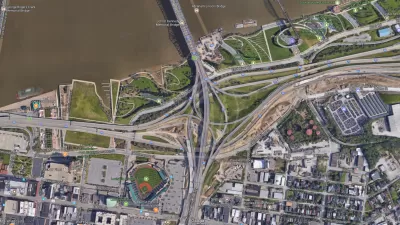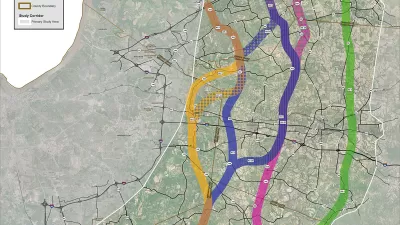Whether you call it the Louisville-Southern Indiana Ohio River Bridges Project, the Downtown Crossing, or the new Spaghetti Junction—call it done.

"With the opening of the East End bridge on Sunday and the official start of tolling set for Friday, Dec. 30, construction of the $2.3 billion Louisville-Southern Indiana Ohio River Bridges Project has pretty much concluded," according to an article by Michael Finley.
"To recap, the bridges project had two major components in the downtown crossing, which included reconfiguring Spaghetti Junction, and the East End crossing, which includes the East End bridge and new roads and tunnels to connect to the bridge," explains Finley. Finley's article provides a retrospective of the project's long construction process.
The Downtown Crossing portion of the project wrapped up construction in November, as reported by Sheldon S. Shafer in a separate article for the Courier-Journal. Earlier this month, the Courier-Journal also commemorated the project by posting aerial images of the completed Spaghetti Junction. Walsh Construction, lead contractor on the project, working with the states of Indiana and Kentucky, also posted a celebratory blog post announcing the end of construction back in November. That project lists the goals and priorities for the project, from the obvious pro-construction perspective of the development team.
For a much more critical take on the pro-highway politics that approved and funded the project, revisit a post by New York Times architecture Michael Kimmelman, who visited the city in 2012.
FULL STORY: From start to finish: One last look at the Downtown Crossing construction

Trump Administration Could Effectively End Housing Voucher Program
Federal officials are eyeing major cuts to the Section 8 program that helps millions of low-income households pay rent.

Planetizen Federal Action Tracker
A weekly monitor of how Trump’s orders and actions are impacting planners and planning in America.

Ken Jennings Launches Transit Web Series
The Jeopardy champ wants you to ride public transit.

Washington Legislature Passes Rent Increase Cap
A bill that caps rent increases at 7 percent plus inflation is headed to the governor’s desk.

From Planning to Action: How LA County Is Rethinking Climate Resilience
Chief Sustainability Officer Rita Kampalath outlines the County’s shift from planning to implementation in its climate resilience efforts, emphasizing cross-departmental coordination, updated recovery strategies, and the need for flexible funding.

New Mexico Aging Department Commits to Helping Seniors Age ‘In Place’ and ‘Autonomously’ in New Draft Plan
As New Mexico’s population of seniors continues to grow, the state’s aging department is proposing expanded initiatives to help seniors maintain their autonomy while also supporting family caregivers.
Urban Design for Planners 1: Software Tools
This six-course series explores essential urban design concepts using open source software and equips planners with the tools they need to participate fully in the urban design process.
Planning for Universal Design
Learn the tools for implementing Universal Design in planning regulations.
Heyer Gruel & Associates PA
Ada County Highway District
Institute for Housing and Urban Development Studies (IHS)
City of Grandview
Harvard GSD Executive Education
Toledo-Lucas County Plan Commissions
Salt Lake City
NYU Wagner Graduate School of Public Service




























